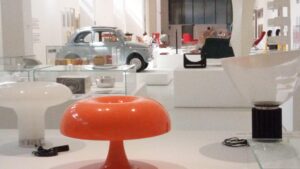Graziella Colombo

Since 2007 Milan has celebrated the evolution of Italian design with a permanent exhibition at Triennale, an institution dedicated to the promotion, conservation and documentation of the history of design in Italy. Open with a newly designed exhibition space, it presents a chronological selection of the most important products from the post-War years to the early 1980s. During these years there was an intense experimentation in new materials – plastic for instance – and techniques which brought great changes in behaviour at home and in society.
Armchairs and chairs, sofas and tables, lamps, TV sets, and bookshelves are some of the many objects on display. There is the famous radio, the Brionvega (1965), formed by two plastic shells joined by a hinge, with an open-

closed combination which indicates when the radio was in use or not. There is the Grillo (cricket) from 1966 designed by Marco Zamuso and Richard Sapper. For years this was the smallest telephone in the world, foreshadowing mobile phones. Its name comes from its snap-open mechanism and ringtone. There is even an example of the Fiat 500 (1960), the very small car so popular in Italy in the 1960s; designed by Dante Giacosa. Nuvola Rossa (red cloud) from 1977 is a bookcase designed by Vico Magistretti: when open it resembles a tepee, when closed a ladder.
As well as showing the the birth and use of new materials and technology the museum also aims to reveal how designers, craftsmen and entrepreneurs worked together to create innovative, interesting objects. For me art and design are two branches of the same tree: that one of creativity, beauty and functionality.
The Trienniale was born in 1923 when the first International Exh

ibition of Decorative Arts was inaugurated at Villa Reale in Monza. In 1933, 10 years later, the exhibition moved to the Palazzo dell’Arte in Milan, a big, modern building with large exhibition halls and public services. Despite the many social and political transformations taking place in Italian cultural and political life over the decades, Triennale has kept its role as a cultural centre where contemporary art and design can be shown and discussed. In 2023 Triennale will celebrate its 100th anniversary.
It has always been a mine of ideas and I hope it will be able to continue on this way.
Designers today face new challenges – recycling, adapting to new materials and developing sustainable projects. Ideas always move, always travel and never die.
